CATALOGUE
view: Salt: The Great March, Indian Council of Cultural RelationsICCR Publication
View the PDF:catalog 2015 ICCR
2013
view: Salt:The Great March, Indira Gandhi National Centre for the Arts Publication
view the PDF :Brochure 1-64
Fragrance of Time, Taste of Memories and Hopes for Future
Catalog essay by Johny ML -Delhi based Curator, Critic , Writer

In Gujarat Vidya Peeth, Ahmedabad, an educational institution established on Gandhian principles, at eleven o’ clock in the morning on every working day, students, teachers and other staff members sit at their charkhas and make khadi yarn. To a modern visitor in the campus this performative act might look a bit outdated and even ritualistic. Even those people who belong to the institution and really do this would partially agree with an outsider’s perception. Clever minds could calculate and say that a person’s thirty hours of effort may not even yield the yarn for a shirt whereas a power loom could churn out cloths for a large number of people. Such cynicism and skepticism, however, do not deter them from doing so. They find a deeper meaning in this ritualistic act and a sane performance. They may not be able to clothe a nation. But they are able to tell themselves that things could be done to perform one’s pious duty towards the nation and for the general upliftment of people through non-violent but affirmative action; hence it carries an important symbolical and metaphorical meaning. Translated into Gandhian terms, performing one’s own pious duty is ‘swadharma’ and upliftment of the masses is ‘sarvodaya’.
The exhibition is titled ‘Salt: The Great March’. For any Indian, there is only one great march and that is the Dandi March undertaken by Mahatma Gandhi in 1930. This was one of the finest socio-political and cultural performances that Gandhiji had devised in order to challenge the economic and political supremacy of the British colonial power over India. Gandhiji, while staying at his Sabarmati Ashram in Ahmedabad carefully planned a grand procession of people, which could inculcate the ideas of nationalism amongst the people all over India. He rightly chose an essential ingredient in the lives of the common people, salt, on which the British rule had levied unaffordable taxes, as his political metaphor and decided to break the draconian salt tax rules by making salt at the Dandi sea shore. Though the British authorities initially avoided a confrontation with Gandhiji as they thought the strike would dissolve itself, they could not overlook the effect soon the march had generated. Dandi sea shore became the venue of confrontation between the aspiration of the Indian people for freedom and autonomy and the colonial powers. The storm that Gandhiji had brewed up while walking to Dandi subsided only with the achievement of freedom though it had come a decade and half later.
Dandi March has always inspired artists from all over the world. A few years back an international artist enacted Dandi March by walking the same distance on a treadmill that Gandhiji had covered from Sabarmati to Dandi sea shore. .Thirty Indian contemporary artists had traveled the same route and created works out of the experience. Artist shelly Jyoti travelled the same route in order to further understand the concepts of swadharma and sarvodaya. While she keeps the political critique that the Gandhian practice could create in today’s world at bay, she insists that culturally and socio-economically, Gandhiji’s idea could be re-invoked in order to solve so many problems of contemporary society. While discussing ‘Salt: The Great March’ speaks of the socio-economic and political status of women in contemporary India.
In Bhuj district of Gujarat, today the ‘azrakh’ textile workers are on the verge of extinction. Artists and designers keep this tradition alive by incorporating these crafts people’s creativity in their artistic works. Though there are Non-Governmental Organizations working in these areas to alleviate them from poverty and untimely extinction. Azrakh is a printing process in which various layers of natural dyes are applied in order to create multiple aesthetical and textural effects. 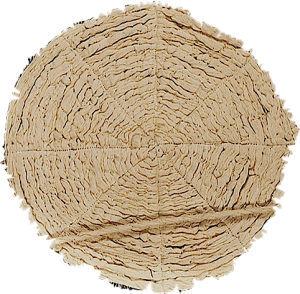 shelly collaborates with the azrakh craftspeople for dying and printing the khadi textile that she has collected from the Khadi Bhandars, a co-operative in the public sector that promotes the use of Khadi amongst the Indian citizens. Through this collaboration she emphasizes two factors: First of all, the Indian middle class that spends a lot of money on their wardrobe should take interest in the traditional clothes and the printing techniques in order to create a feasible atmosphere for these crafts from dyeing. Secondly, she says that use of Khadi should not be a ritualistic affair in order to feel nationalistic during the month of October when the Khadi Bhandars offer a lot of discounts on khadi products. let khadi become a contemporary alternative to salt and perhaps it could be subtly employed to push a sarvodaya agenda through the perusal of swadharma in our personal lives.
shelly collaborates with the azrakh craftspeople for dying and printing the khadi textile that she has collected from the Khadi Bhandars, a co-operative in the public sector that promotes the use of Khadi amongst the Indian citizens. Through this collaboration she emphasizes two factors: First of all, the Indian middle class that spends a lot of money on their wardrobe should take interest in the traditional clothes and the printing techniques in order to create a feasible atmosphere for these crafts from dyeing. Secondly, she says that use of Khadi should not be a ritualistic affair in order to feel nationalistic during the month of October when the Khadi Bhandars offer a lot of discounts on khadi products. let khadi become a contemporary alternative to salt and perhaps it could be subtly employed to push a sarvodaya agenda through the perusal of swadharma in our personal lives.
Hence, the artist chooses to work on khadi in the place of salt with a reference to Gandhiji’s ultimate pragmatic ways of popularizing khadi during the days of struggle for independence. Gandhiji made khadi as a way of life not only by wearing khadi clothes but also by working at charkha to produce his own khadi yarn. During the Dandi March, it is reported that Gandhiji took two bullock carts along with him; one filled with khadi and the other with his western commode.At the khadi front, the bullock cart became a mobile showroom of khadi cloth. Gandhiji asked the people who had thronged along the way to have a glimpse of the great leader to buy khadi. He asked them to make wearing khadi a habit and also he made it a point that some funds for the march could be raised by selling khadi. Gandhiji was a benevolent pragmatist with a lot of imagination. He imagined an India of villages and even he thought that the future of our nation lay in the villages. He had complete faith in his people as well as in his persuasive powers. In our narratives on Indian independence khadi and salt are intricately connected with each other. While salt connotes the basic necessity of food, khadi stands in for clothing; and his grand dream was to provide them with a shelter, the free nation.
The artist poetically alludes to salt through khadi. Her works are printed with traditional Azrakh prints on khadi .She has also incorporated the service of the people who are the traditional needle workers who make quilts as a part of their daily existence. However, these works are not quilts. Even when they could be used as quilts, The focus is not on converting them into usable objects.  She deliberately wants them to remain in the aesthetical zone so that it could be validated in the socio-economic and politico-cultural debates. So there is a fair amount of de-functionalizing of the products of these artisans here. By taking them out of their user context, Shelly attributes them with metaphorical and symbolic values.
She deliberately wants them to remain in the aesthetical zone so that it could be validated in the socio-economic and politico-cultural debates. So there is a fair amount of de-functionalizing of the products of these artisans here. By taking them out of their user context, Shelly attributes them with metaphorical and symbolic values.
Angst ridden when she writes a poem about our times or about the experiences that have led her to the making of this set of works. She, as an involved social being, is worried about the kind of atr ocities committed against women in general by the patriarchal thoughts and behavioural patterns. She explores the possibility of extending the debate to this issue by creating a set of works using a small girl’s frock in khadi cloth. ‘Let Her Grow up Without Fear’ is a title that she gives to a couple of works with frock as the central imagery. Here, she takes the whole debate around khadi and salt or even the Gandhian philosophy to a new direction and poses this question of women’s status in the society. A girl’s frock is a powerful symbol as today even the pre-pubescent girls are not spared by the criminals.
ocities committed against women in general by the patriarchal thoughts and behavioural patterns. She explores the possibility of extending the debate to this issue by creating a set of works using a small girl’s frock in khadi cloth. ‘Let Her Grow up Without Fear’ is a title that she gives to a couple of works with frock as the central imagery. Here, she takes the whole debate around khadi and salt or even the Gandhian philosophy to a new direction and poses this question of women’s status in the society. A girl’s frock is a powerful symbol as today even the pre-pubescent girls are not spared by the criminals.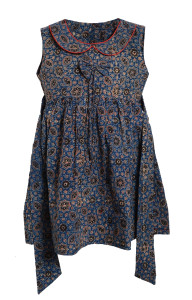
Along with the quilts and the two dimensional works made out of khadi and azrakh, are site specific installations that function between material exploration and sculptural experimentation. In one of the installations titled, ‘Integrating Khadi 2013’, printed Sanskrit texts on khadi scriptures are meant to refer to the centuries old heritage of India and the artist feels that one should take a great pride in being a part of that tradition. But what makes me more thoughtful while looking at this work is its emphasis on the rupture that has occurred between the past and present. The past has become a point of embellishment while the present remains anchorless and abandoned. Besides, the whole installation has a kinetic feeling that simulates the walking style of Gandhiji who preferred to walk briskly.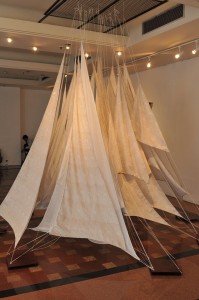
The cubistic approach is not a permanent feature in Shelly’s works. The static nature of the former installation is considerably broken when she interprets the idea of making the nation through an interactive installation. This work titled, ‘Re-buiding my Nation’ is made out of chennile pipe cleaners, khadi yarn and fabric. This shows how different elements could live in a single entity without contesting each other’s presence. The interactivity could take place when the viewers could rearrange the chakras made out of the soft pipe on the hanging mesh made out of fabric and yarn. Hence, each re-arrangement that would take place in the gallery space becomes an extension of her optimism which people also share with a lot of enthusiasm. Gandhiji’s playful performances, which had grave connotations often resulted into positive changes, 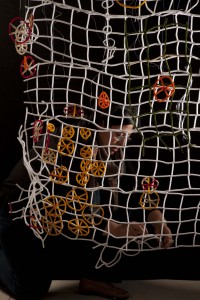 Shelly too aspires to create a playful environment where grave philosophies of pacifism and humanitarianism could be touched and felt rather than seen and enjoyed.
Shelly too aspires to create a playful environment where grave philosophies of pacifism and humanitarianism could be touched and felt rather than seen and enjoyed.
One installation, which is minimal both in execution and presentation, needs further elaboration. Titled, ‘The Threads of Swaraj’, this work is a silent but efficient tribute to all those people who had and have contributed to the building of our nation through Gandhian ways. Along the route that Gandhiji had taken to reach the Dandi sea shore there are still some people living with vivid memories of partaking in that great movement and seeing Gandhiji in person for once. During her research trip, Shelly visited a few of them (Dhirubhai, Gosai Bhai Patel and so on) and interviewed them extensively. Their memories are like yarns of khadi; the more they work on it the more they keep coming. The more they enjoy those memories the more they feel grateful to Mahatma Gandhi. These veteran freedom fighters are like the craftspeople and crafts traditions are becoming an extinctive group. From the thought that these great souls should be admired, adorned and revered for the sacrifices that they had done for the society, the artist makes this installation which has khadi yarn as the main ingredient.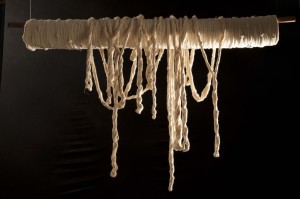 The yarn collected from (50,000 meters of it) from Panch Kaka ni Vaadi, a village near Dandi, the artist makes this simple installation, which has a khadi clad pipe as a holder for hanging khadi yarn. They are not shaped or elegantly designed threads. They are as coarse and rough as unrefined khadi. But they have a softer inner core and their very existence in our contemporary society makes any one brood on their validity. They are outdated, some may say, but their lives have been useful to us without our knowledge. They are to be given a place in our minds; like the clothes that we hang up after use and take them out again inspired by nostalgia or love.
The yarn collected from (50,000 meters of it) from Panch Kaka ni Vaadi, a village near Dandi, the artist makes this simple installation, which has a khadi clad pipe as a holder for hanging khadi yarn. They are not shaped or elegantly designed threads. They are as coarse and rough as unrefined khadi. But they have a softer inner core and their very existence in our contemporary society makes any one brood on their validity. They are outdated, some may say, but their lives have been useful to us without our knowledge. They are to be given a place in our minds; like the clothes that we hang up after use and take them out again inspired by nostalgia or love.
Shelly Jyoti’s ‘Salt: The Great March’ is emblematic of her philosophical and aesthetical involvement with Gandhian ideals. It is her desire to live in more humane world. It is an evocation of something being forgotten. It is like a reminder. It is like an old letter suddenly found out. It has the fragrance of time, taste of memories and hopes for the future.
September 2013, New Delhi

